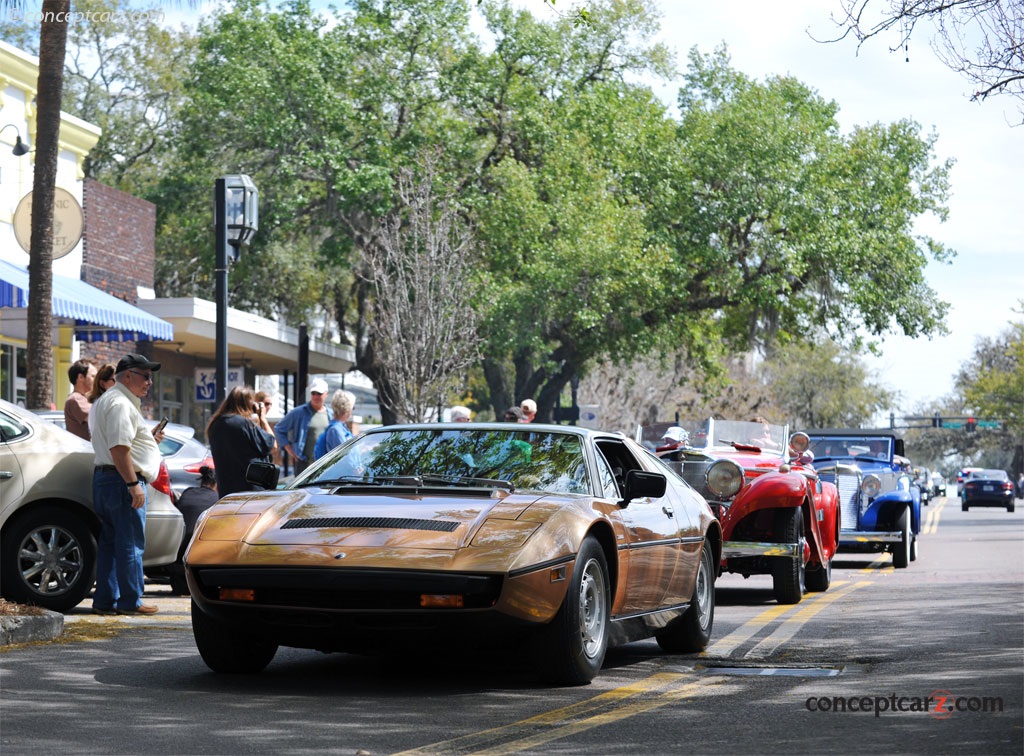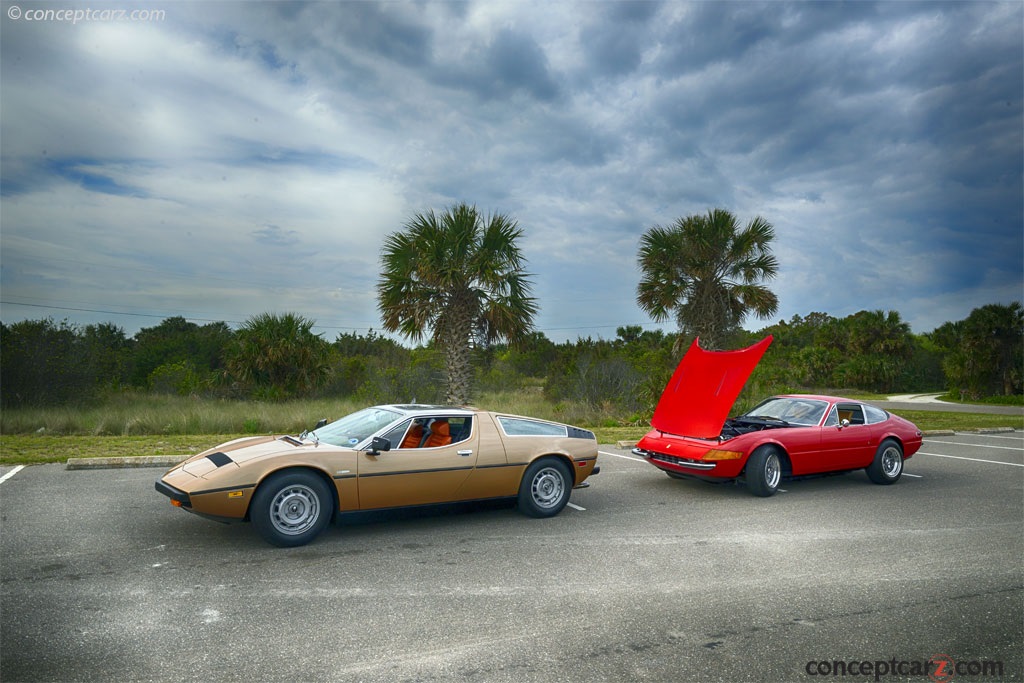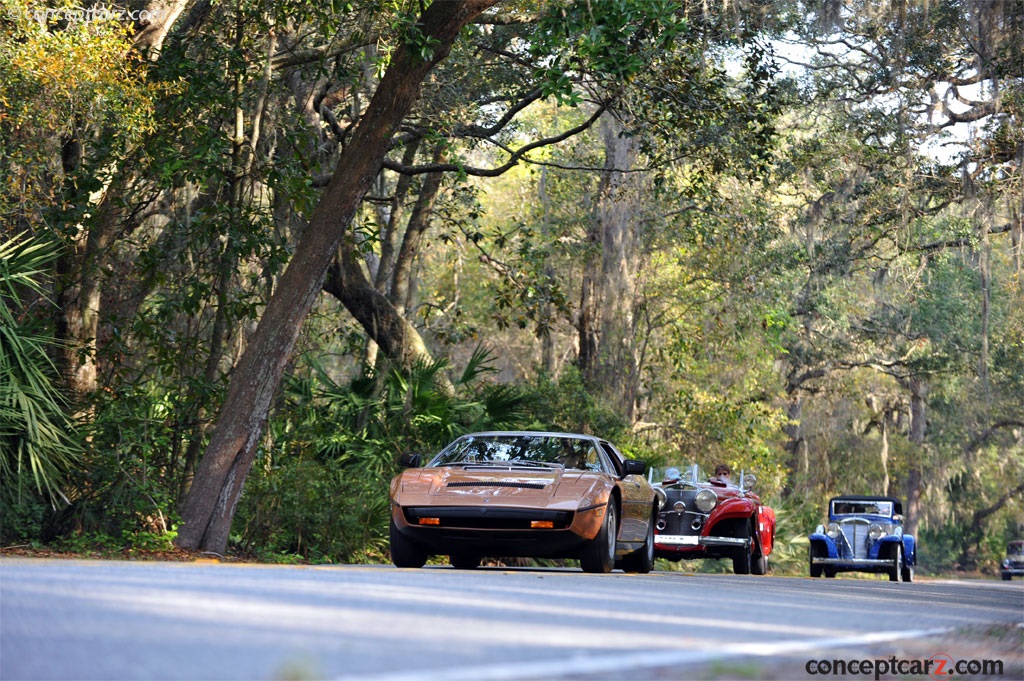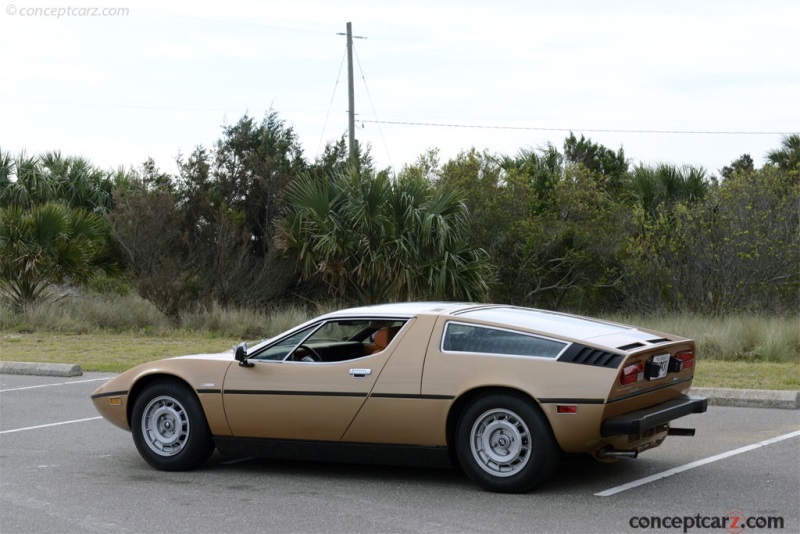1977 Maserati Bora Navigation
Mid-engine placement revolutionized the sports car market and automakers were quick to embrace the trend for its numerous benefits. Maserati's first abandonment of traditional tubular chassis technology and its embracing of unitary construction and rear-mounted engine was with the Bora, introduced in March 1971 at the Geneva auto show. Development had begun in October 1968, the same year that Citroen had acquired a controlling interest in Maserati. A road-going prototype had been created by mid-1969 and deliveries commenced before the end of 1971. 
Coupe
Chassis #: AM117US1028Initially known as Tipo 117 and later the Bora, it was named after a lively breeze local to the eastern Adriatic coast - the wind of Trieste. The Maserati Bora's internal engineering was overseen by Giulio Alfieri, co-designer of the legendary 250F Formula 1 Grand Prix car, and exterior styling was courtesy of Giorgetto Giugiaro of Italdesign. The V8 engine was shared with the Ghibli SS, and the hydropneumatic control system was supplied by Citroen and powered the ventilated disk brakes and allowed for 'touch button' movement of the pedal box, driving seat position, headlights, and windows.Mechanical Specification
Chassis
The Maserati Bora rested on a 102.4-inch wheelbase chassis with an overall length of 170.7 inches, a width of 69.6 inches, and a height of 44.6 inches. Compared to the front-engine Ghibli (1967 to 1973), the Bora had a 2-inch longer wheelbase, 14.3-inch shorter length, 0.9-inch shorter width, and 1.1-inch shorter height.
Coupe
Chassis #: AM117US1028The steel monocoque chassis had a tubular steel subframe at the back for carrying the engine and transmission. The four-wheel independent suspension was a first for a Maserati passenger car and was comprised of wishbones, coil springs, anti-roll bars, and telescopic suspension dampers. The developmental prototype example had MacPherson struts at the front which were abandoned for the production version due to the severe drivability issue. Steering was via rack-and-pinion, the wheels were 7.5 in × 15 in Campagnolo light alloy type with removable polished stainless steel hubcaps in the earlier models, and the tires were Michelin XWX 205x70 front and rear. Due to 'tramlining' at speed, Maserati soon replaced the rear tires with 215/70VR15 tires, offering a choice of Michelin XWX or Pirelli Cinturato CN12 tires.Engine
The V-8 engine powering the Maserati Bora was derived from the company's Birdcage Tipo 63-65 race cars and the 450S. It was built from aluminum alloy and had an 8.5:1 compression ratio, 16 valves operated by four chain-driven cams, hemispherical combustion chambers, four 42 DCNF/14 downdraught Weber carburetors, and Bosch electronic ignition. The engine was mounted longitudinally mid-ship and mounted to a ZF-1 five-speed transaxle sending power to the rear wheels. Both the transmission and engine were mounted on a subframe attached to the floor pan by four flexible mounts.Displacement in the Bora initially measured 4,719cc (4.7 liters / 288 cubic inches / Tipo AM 107.07) and offered 306 horsepower at 6,000 RPM and 340 lb-ft (461 Nm) of torque at 4,200 RPM. Examples destined for the United States received the larger 4930 cc (4.9-liter / Tipo AM 107.16) unit from the Ghibli, compensating for the reduction in power due to the exhaust emission regulations. In 1976, Maserati dropped the 4.7-liter unit and solely fitted the 4.9-liter engine. This larger and more powerful version (compared to the 4.7-liter unit) had an 8.75:1 compression ratio and produced 325 horsepower at 5,500 RPM and 355 lb-ft (481 Nm) of torque at 4,000 RPM (non-US Specification.Hydropneumatic Control System
The Hydropneumatic system sourced from Citroen added a level of sophistication, practicality and civility to the Bora that was lacking from other supercars. The hydraulically powered pedal cluster (brake, clutch, and throttle) could be moved forward and backward at the touch of a button, and the steering wheel could be tilted and/or telescoped with similar ease. The driver's seat could be adjusted vertically, and the auxiliary hydraulic circuit system also powered the pop-up headlights, ventilated disc brakes, and windows. Styling
The Giorgetto Giugiaro-designed Bora had a wedge-shaped design with concealed (pop-up) headlights in the front fenders and brushed stainless steel roof and windscreen pillars. There was a full-size trunk in the front of the vehicle, a glass-enclosed cover over the rear engine, and the steel body panels were fabricated by Officine Padane of Modena. The very low drag coefficient of 0.30 greatly contributed to the vehicle's performance and its sporty persona.Road and engine noise was quieted by the dual-pane insulative glazing separating the cabin from the engine compartment, and the carpeted aluminum engine cap also greatly contributed to the reduction in vibration and noise. The US-bound cars were given larger and more substantial bumpers to comply with bumper standards. The US and Canadian market cars had red instead of amber taillamps and turn signal indicators. Around early 1974, the pop-up headlights were given rounded inside corners, a rectangular black air-exit grille was added across the hood, and the front lid was now hinged at the front instead of rear.Interior
The interior contained buckets seats wrapped in leather and standard electric windows and air conditioning. The door trim, dash, center console, and rear bulkhead were also trimmed in leather. Production
Production of the Bora with the 4.7-liter powerplant lasted from 1971 to 1978 with 289 examples built. Production of the 4.9-liter Bora began in 1973 and ceased in 1978, with 275 units constructed. The total production of 4.7- and 4.9-liter Boras was 564 units.Performance
The Bora 4.7 was capable of achieving a top speed of 270 km/h (168 mph) and the Bora 4.9 could reach speeds of 285 km/h (177 mph).
by Daniel Vaughan | Jun 2024
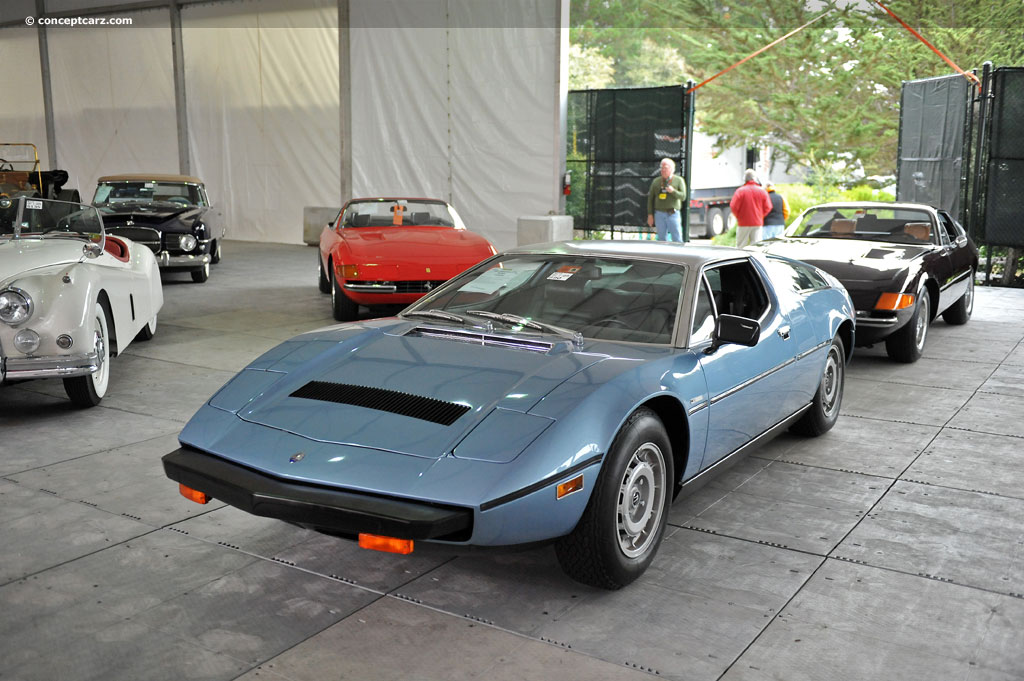
Coupe
Chassis #: AM117US1028
Chassis
The Maserati Bora rested on a 102.4-inch wheelbase chassis with an overall length of 170.7 inches, a width of 69.6 inches, and a height of 44.6 inches. Compared to the front-engine Ghibli (1967 to 1973), the Bora had a 2-inch longer wheelbase, 14.3-inch shorter length, 0.9-inch shorter width, and 1.1-inch shorter height.
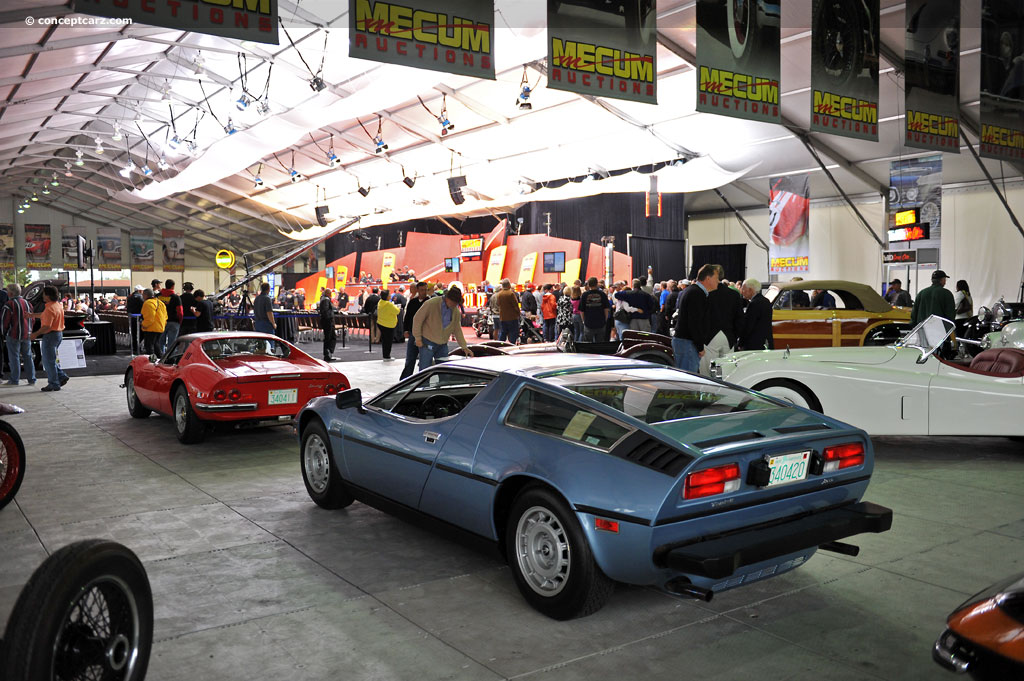
Coupe
Chassis #: AM117US1028
The V-8 engine powering the Maserati Bora was derived from the company's Birdcage Tipo 63-65 race cars and the 450S. It was built from aluminum alloy and had an 8.5:1 compression ratio, 16 valves operated by four chain-driven cams, hemispherical combustion chambers, four 42 DCNF/14 downdraught Weber carburetors, and Bosch electronic ignition. The engine was mounted longitudinally mid-ship and mounted to a ZF-1 five-speed transaxle sending power to the rear wheels. Both the transmission and engine were mounted on a subframe attached to the floor pan by four flexible mounts.Displacement in the Bora initially measured 4,719cc (4.7 liters / 288 cubic inches / Tipo AM 107.07) and offered 306 horsepower at 6,000 RPM and 340 lb-ft (461 Nm) of torque at 4,200 RPM. Examples destined for the United States received the larger 4930 cc (4.9-liter / Tipo AM 107.16) unit from the Ghibli, compensating for the reduction in power due to the exhaust emission regulations. In 1976, Maserati dropped the 4.7-liter unit and solely fitted the 4.9-liter engine. This larger and more powerful version (compared to the 4.7-liter unit) had an 8.75:1 compression ratio and produced 325 horsepower at 5,500 RPM and 355 lb-ft (481 Nm) of torque at 4,000 RPM (non-US Specification.Hydropneumatic Control System
The Hydropneumatic system sourced from Citroen added a level of sophistication, practicality and civility to the Bora that was lacking from other supercars. The hydraulically powered pedal cluster (brake, clutch, and throttle) could be moved forward and backward at the touch of a button, and the steering wheel could be tilted and/or telescoped with similar ease. The driver's seat could be adjusted vertically, and the auxiliary hydraulic circuit system also powered the pop-up headlights, ventilated disc brakes, and windows. Styling
The Giorgetto Giugiaro-designed Bora had a wedge-shaped design with concealed (pop-up) headlights in the front fenders and brushed stainless steel roof and windscreen pillars. There was a full-size trunk in the front of the vehicle, a glass-enclosed cover over the rear engine, and the steel body panels were fabricated by Officine Padane of Modena. The very low drag coefficient of 0.30 greatly contributed to the vehicle's performance and its sporty persona.Road and engine noise was quieted by the dual-pane insulative glazing separating the cabin from the engine compartment, and the carpeted aluminum engine cap also greatly contributed to the reduction in vibration and noise. The US-bound cars were given larger and more substantial bumpers to comply with bumper standards. The US and Canadian market cars had red instead of amber taillamps and turn signal indicators. Around early 1974, the pop-up headlights were given rounded inside corners, a rectangular black air-exit grille was added across the hood, and the front lid was now hinged at the front instead of rear.Interior
The interior contained buckets seats wrapped in leather and standard electric windows and air conditioning. The door trim, dash, center console, and rear bulkhead were also trimmed in leather. Production
Production of the Bora with the 4.7-liter powerplant lasted from 1971 to 1978 with 289 examples built. Production of the 4.9-liter Bora began in 1973 and ceased in 1978, with 275 units constructed. The total production of 4.7- and 4.9-liter Boras was 564 units.Performance
The Bora 4.7 was capable of achieving a top speed of 270 km/h (168 mph) and the Bora 4.9 could reach speeds of 285 km/h (177 mph).
by Daniel Vaughan | Jun 2024
Related Reading : Maserati Bora History
The Bora was introduced in 1971 and produced until 1978 with over 570 examples produced. It was a 2-door coupe with the engine placed in the middle, powering the rear wheels. Ferrari had been in the process of creating a mid-engined sports car while Lamborghini and DeTomaso had their Countach, Miura, and Mangusta, and the mid-engined Ford GT40 had even made a few appearances at LeMans. After seeing....
Continue Reading >>
Continue Reading >>
- 1977 Maserati Bora Menu
- Article
- Image gallery
- Valuation
- Specifications
- Profiles
Maserati
Similar Vehicles
Similar Automakers
Similarly Sized Vehicles
from 1977
1977 Maserati Bora Vehicle Profiles
Recent Vehicle Additions
Performance and Specification Comparison
Price Comparison
$29,810
$41,455
Bora Specification Comparison by Year
Year
Production
Wheelbase
Engine
Prices
Related Automotive News

Maserati Bora turns 50
Maserati celebrates the Bora, the first mid-mounted rear engine road car in the Brands history, just as the MC20 is the first mid-mounted rear engine vehicle in the new Era.
The wind of the Maserati Bora spans through 50 years of history, and reaches...
Citroën Celebrates 100 Years Of Iconic Cars At The London Classic Car Show
Citroën will showcase some of its most iconic vehicles at this years London Classic Car Show to mark its centenary. The show runs from 14 - 17 February at ExCel London and will feature a selection of Citroën vehicles that have made a significant impression...

THE McLAREN F1
FOR THE DRIVER VITALLY – AS IN ONE OF McLARENS WORLD CHAMPION RACING CARS – DRIVER AND VEHICLE BECOME ENTIRELY AS ONE
The primary design consideration for the McLaren F1 has been to make it without reserve a drivers car, an extremely high-performance...

FORMULA E UNVEILS NEW SPARK-RENAULT SRT_01E AT FRANKFURT MOTOR SHOW
FIA President Jean Todt takes wraps off revolutionary new fully-electric racer for 20142015 FIA Formula E Championship
FRANKFURT, GERMANY (September 10, 2013) – FIA President Jean Todt and Alejandro Agag, CEO of Formula E Holdings, revealed...

12C SPIDER TO MAKE ITALIAN PREMIERE AT THE 37TH BOLOGNA MOTOR SHOW
Italian debut of the 12C Spider – new Spider version of highly acclaimed 12C
Developed alongside 12C as a pure McLaren – including revised 625PS 3.8-litre V8 twin-turbo engine
Carbon fibre MonoCell ensures class-leading rigidity, handling and...
